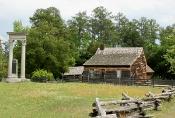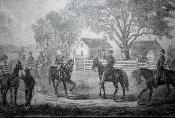Bennett Place State Historic Site - Durham, North Carolina
| Bennett Place State Historic Site The Bennett house, site of Joseph E. Johnston's surrender to William Tecumseh Sherman, has been reconstructed in Durham, North Carolina. |
Bennett Place, North Carolina
The house (left) and kitchen
have been reconstructed on
their original sites at Bennett
Place State Historic Sites.
The house (left) and kitchen
have been reconstructed on
their original sites at Bennett
Place State Historic Sites.
Gateway to History
Generals Johnston and
Sherman died their horses
near a well and this path to
the Bennett Place.
Generals Johnston and
Sherman died their horses
near a well and this path to
the Bennett Place.
The Largest Surrender
Johnston's surrender to
Sherman here in the Bennett
House was the largest troop
surrender of the Civil War.
Johnston's surrender to
Sherman here in the Bennett
House was the largest troop
surrender of the Civil War.
Bennett Place State Historic Site - Durham, NC
The Largest Troop Surrender
Hampton vs. Kilpatrick
Legend holds that cavalry
generals Wade Hampton and
Judson Kilpatrick engaged in
a fist fight in the yard and had
to be separated by the two
commanding generals.
Legend holds that cavalry
generals Wade Hampton and
Judson Kilpatrick engaged in
a fist fight in the yard and had
to be separated by the two
commanding generals.
| Copyright 2011, 2014 & 2015 by Dale Cox All rights reserved. Last Updated: March 21, 2015 |
In April of 1865, Union General William T.
Sherman and Confederate General Joseph
E. Johnston met at the Bennett Place in North
Carolina and negotiated the largest troop
surrender of the Civil War.
It was at the Bennett Place and not at
Appomattox Court House, that the war in the
East finally came to a close.
Now preserved as a state historic site, the
Bennett Place was a family farm in North
Carolina. The land was tilled by the men and
boys of the family as the Bennetts held no
slaves. Although more successful than many
such family farms in the South, the Bennett
place held no special significance until April
of 1865.
In a remarkable effort, General Joseph E.
Johnston had reassembled the Confederate
Army of Tennessee from the wreckage of the
fighting force shattered at the Battles of
Franklin and Nashville in Tennessee. As
General William Tecumseh Sherman moved
north into the Carolinas following his March
to the Sea, Johnston moved north as well.
The Confederate army was outnumbered
and outgunned, but still more than willing to
put up a fight, as Sherman learned at the
Battle of Bentonville, North Carolina, on
March 19-21, 1865. Johnston fell on one
wing of Sherman's army and came very close
to destroying it before Union reinforcements
could reach the scene.
By early April of 1865, the two armies facing
each other from the cities of Hillsborough
and Raleigh in northern North Carolina. The
Confederates had been trying to reach
Virginia to join forces with the army under
General Robert E. Lee, but then word arrived
that Lee had surrendered to General Ulysses
S. Grant on April 9th.
President Jefferson Davis, fleeing south after
the fall of Richmond, met with Johnston and
ordered him to continue the fight, even if that
meant allowing the conflict to deteriorate into
guerrilla warfare. The President continued
his flight to the Deep South, leaving General
Johnston to deal with the enormous weight
that had thus been placed on his shoulders.
Knowing that he could not defeat the armies
of both Grant and Sherman once they
combined and unwilling to launch a guerrilla
war that could drench the South in blood for
generations, Johnston resolved to meet with
Sherman.
The Confederate general sent a message
through the lines to his Union counterpart
and then started east on the road from
Hillsborough to Durham Station (now the City
of Durham). Sherman received Johnston's
message and started west from Raleigh on
the same road.
The two generals met on April 17, 1865, in an
area of open fields and woods. They decided
to find a house where they could meet in
private. Johnston had passed a cluster of
homes so the two generals, accompanied by
their cavalry escorts, turned back west.
They approached one house but were turned
away when the occupants refused to allow a
Yankee (Sherman) to enter their home. Thus
rebuffed, they continued on to the Bennett
Place.
James and Nancy Bennett agreed to let
Johnston and Sherman use their home. To
give the two generals privacy, the family
graciously moved from the house to their log
kitchen building, which stood across the yard.
The meeting between the two generals, who
had battled each other through the Atlanta
Campaign and again in the Carolinas, was
given added gravity when Sherman handed
General a secret telegram just received from
Washington. It announced the assassination
of President Abraham Lincoln.
Johnston wanted time to consider things and
the two men decided to meet again the next
day. Returning to their respective forces for
the night, they came back to the farm the next
day.
There at the Bennett Place, on April 18, 1865,
Joseph E. Johnston agreed to surrender the
Army of Tennessee.
Sherman had offered Johnston generous
terms that he hoped would not just end the
fighting, but help restore the Southern states
to the Union as peacefully and quickly as
possible. Johnston's acceptance, both men
believed, would end the war on honorable
terms in accordance with Lincoln's vision of
"malice toward none, with charity for all."
Sherman and Confederate General Joseph
E. Johnston met at the Bennett Place in North
Carolina and negotiated the largest troop
surrender of the Civil War.
It was at the Bennett Place and not at
Appomattox Court House, that the war in the
East finally came to a close.
Now preserved as a state historic site, the
Bennett Place was a family farm in North
Carolina. The land was tilled by the men and
boys of the family as the Bennetts held no
slaves. Although more successful than many
such family farms in the South, the Bennett
place held no special significance until April
of 1865.
In a remarkable effort, General Joseph E.
Johnston had reassembled the Confederate
Army of Tennessee from the wreckage of the
fighting force shattered at the Battles of
Franklin and Nashville in Tennessee. As
General William Tecumseh Sherman moved
north into the Carolinas following his March
to the Sea, Johnston moved north as well.
The Confederate army was outnumbered
and outgunned, but still more than willing to
put up a fight, as Sherman learned at the
Battle of Bentonville, North Carolina, on
March 19-21, 1865. Johnston fell on one
wing of Sherman's army and came very close
to destroying it before Union reinforcements
could reach the scene.
By early April of 1865, the two armies facing
each other from the cities of Hillsborough
and Raleigh in northern North Carolina. The
Confederates had been trying to reach
Virginia to join forces with the army under
General Robert E. Lee, but then word arrived
that Lee had surrendered to General Ulysses
S. Grant on April 9th.
President Jefferson Davis, fleeing south after
the fall of Richmond, met with Johnston and
ordered him to continue the fight, even if that
meant allowing the conflict to deteriorate into
guerrilla warfare. The President continued
his flight to the Deep South, leaving General
Johnston to deal with the enormous weight
that had thus been placed on his shoulders.
Knowing that he could not defeat the armies
of both Grant and Sherman once they
combined and unwilling to launch a guerrilla
war that could drench the South in blood for
generations, Johnston resolved to meet with
Sherman.
The Confederate general sent a message
through the lines to his Union counterpart
and then started east on the road from
Hillsborough to Durham Station (now the City
of Durham). Sherman received Johnston's
message and started west from Raleigh on
the same road.
The two generals met on April 17, 1865, in an
area of open fields and woods. They decided
to find a house where they could meet in
private. Johnston had passed a cluster of
homes so the two generals, accompanied by
their cavalry escorts, turned back west.
They approached one house but were turned
away when the occupants refused to allow a
Yankee (Sherman) to enter their home. Thus
rebuffed, they continued on to the Bennett
Place.
James and Nancy Bennett agreed to let
Johnston and Sherman use their home. To
give the two generals privacy, the family
graciously moved from the house to their log
kitchen building, which stood across the yard.
The meeting between the two generals, who
had battled each other through the Atlanta
Campaign and again in the Carolinas, was
given added gravity when Sherman handed
General a secret telegram just received from
Washington. It announced the assassination
of President Abraham Lincoln.
Johnston wanted time to consider things and
the two men decided to meet again the next
day. Returning to their respective forces for
the night, they came back to the farm the next
day.
There at the Bennett Place, on April 18, 1865,
Joseph E. Johnston agreed to surrender the
Army of Tennessee.
Sherman had offered Johnston generous
terms that he hoped would not just end the
fighting, but help restore the Southern states
to the Union as peacefully and quickly as
possible. Johnston's acceptance, both men
believed, would end the war on honorable
terms in accordance with Lincoln's vision of
"malice toward none, with charity for all."

Custom Search
Alamance Battleground State Historic Site
Guilford Courthouse National Military Park
Battleship U.S.S. North Carolina
Bentonville Battlefield State Historic Site
Blue Ridge Parkway
Historic Stagville State Historic Site
Oak Island Lighthouse
"Old Baldy" - Baldhead Island Lighthouse
Old Brunswick County Jail
Old Smithville Burying Ground
Guilford Courthouse National Military Park
Battleship U.S.S. North Carolina
Bentonville Battlefield State Historic Site
Blue Ridge Parkway
Historic Stagville State Historic Site
Oak Island Lighthouse
"Old Baldy" - Baldhead Island Lighthouse
Old Brunswick County Jail
Old Smithville Burying Ground





The agreement, however, was received in
Washington by officials irate over the Lincoln
assassination and appalled that Sherman
would agree to terms that treated the
Southerners with such dignity. They rejected
the agreement.
Personally humiliated and even vilified as a
possible rebel himself by some in the North,
Sherman notified Johnston of the decision. If
the Confederate general did not accept new,
more stringent, terms within 48 hours,
hostilities would resume.
Ordered by Jefferson Davis to dissolve his
infantry into guerrilla bands to continue the
fight, Johnston now faced the prospect his
surrendering his army a second time.
Personally and professionally humiliated, he
nevertheless shouldered the responsibility of
deciding the future of the South and again
agreed to meet with Sherman. On April 26,
1865, the two officers met again at the
Bennett Place, where Johnston signed the
surrender terms as dictated by Washington.
The surrender included all Confederate
forces in North Carolina, South Carolina,
Georgia and Florida - 89,270 soldiers in all -
and was the largest troop surrender of the
Civil War. Other surrenders would follow in
Alabama and west of the Mississippi, but the
surrender of the Army of Tennessee at the
Bennett Place ended for good any prospect
of continuing the war in the East.
Johnston and Sherman became close
friends after the war. The latter general, in
fact, died of pneumonia after standing bare-
headed in a cold rain to show his respect at
his former enemy's funeral.
Had the original terms negotiated at the
Bennett Place been accepted, the South
might well have escaped the horrible days of
Reconstruction. It was not to be, however,
and the dark cloud of war was replaced by
the even darker cloud of military rule that
would continue in the southern states for
another decade.
Like most families in the region, the Bennetts
were left impoverished by the war. They had
lost three sons in the conflict and by 1880,
following the death of James Bennett, had
given up the farm and moved into Durham.
The original house eventually collapsed on
its own and by the time preservation efforts
began at the site only the chimney remained.
Using sketches made in 1865 as a guide,
the house was reconstructed, as were the
kitchen, other outbuildings and fences. The
farm is now preserved as Bennett Place
State Historic Site.
Other features of the site include outstanding
museum displays. the Unity Monument
erected in 1923 and a section of the original
road used by Sherman and Johnston in 1865.
Bennett Place State Historic Site is located at
4409 Bennett Memorial Road in Durham,
North Carolina. The park is open Tuesday -
Saturday from 9 a.m. to 5 p.m. There is no
charge to visit the site or participate in the
guided tours.
Please click here to visit the official website
for more information.
Washington by officials irate over the Lincoln
assassination and appalled that Sherman
would agree to terms that treated the
Southerners with such dignity. They rejected
the agreement.
Personally humiliated and even vilified as a
possible rebel himself by some in the North,
Sherman notified Johnston of the decision. If
the Confederate general did not accept new,
more stringent, terms within 48 hours,
hostilities would resume.
Ordered by Jefferson Davis to dissolve his
infantry into guerrilla bands to continue the
fight, Johnston now faced the prospect his
surrendering his army a second time.
Personally and professionally humiliated, he
nevertheless shouldered the responsibility of
deciding the future of the South and again
agreed to meet with Sherman. On April 26,
1865, the two officers met again at the
Bennett Place, where Johnston signed the
surrender terms as dictated by Washington.
The surrender included all Confederate
forces in North Carolina, South Carolina,
Georgia and Florida - 89,270 soldiers in all -
and was the largest troop surrender of the
Civil War. Other surrenders would follow in
Alabama and west of the Mississippi, but the
surrender of the Army of Tennessee at the
Bennett Place ended for good any prospect
of continuing the war in the East.
Johnston and Sherman became close
friends after the war. The latter general, in
fact, died of pneumonia after standing bare-
headed in a cold rain to show his respect at
his former enemy's funeral.
Had the original terms negotiated at the
Bennett Place been accepted, the South
might well have escaped the horrible days of
Reconstruction. It was not to be, however,
and the dark cloud of war was replaced by
the even darker cloud of military rule that
would continue in the southern states for
another decade.
Like most families in the region, the Bennetts
were left impoverished by the war. They had
lost three sons in the conflict and by 1880,
following the death of James Bennett, had
given up the farm and moved into Durham.
The original house eventually collapsed on
its own and by the time preservation efforts
began at the site only the chimney remained.
Using sketches made in 1865 as a guide,
the house was reconstructed, as were the
kitchen, other outbuildings and fences. The
farm is now preserved as Bennett Place
State Historic Site.
Other features of the site include outstanding
museum displays. the Unity Monument
erected in 1923 and a section of the original
road used by Sherman and Johnston in 1865.
Bennett Place State Historic Site is located at
4409 Bennett Memorial Road in Durham,
North Carolina. The park is open Tuesday -
Saturday from 9 a.m. to 5 p.m. There is no
charge to visit the site or participate in the
guided tours.
Please click here to visit the official website
for more information.
Battle of Bentonville
Duke Homestead State Historic Site
Historic Stagville
Alamance Battleground
Appomattox Court House
Surrender at Citronelle
Battlefields and Forts of the South
Historic Sites of North Carolina
Explore other Southern History Sites
Duke Homestead State Historic Site
Historic Stagville
Alamance Battleground
Appomattox Court House
Surrender at Citronelle
Battlefields and Forts of the South
Historic Sites of North Carolina
Explore other Southern History Sites
Bennett Place
The Unity Monument, at left,
was erected in 1923 in tribute
of the role the surrender at
Bennett Place played in the
rebuilding of the country.
The Unity Monument, at left,
was erected in 1923 in tribute
of the role the surrender at
Bennett Place played in the
rebuilding of the country.

Meeting at Bennett Place
This wartime sketch shows
Johnston and Sherman on
horseback in the roadway
with the Bennett house and
kitchen in the background.
This wartime sketch shows
Johnston and Sherman on
horseback in the roadway
with the Bennett house and
kitchen in the background.

Museum at Bennett Place
The visitor center features an
outstanding museum with
displays explaining the history
of the Bennett Place as well
as a wide array of Civil War
artifacts.
The visitor center features an
outstanding museum with
displays explaining the history
of the Bennett Place as well
as a wide array of Civil War
artifacts.

History in North Carolina
